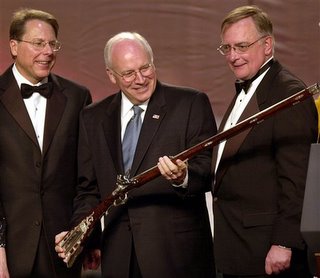Cheney's got a PR problem

John Wagner's recent post asks "Is Dick Cheney's hunting accident newsworthy?"
Clearly, the vice-president's accident is newsworthy: it would be newsworthy if a local citizen shot another local citizen in the same manner. What makes it more newsworthy - growing bigger and lasting longer, perhaps - is the way it was handled. He didn't tell his story and the media filled in the blanks.
According to A Practical Guide to Planning for and Responding to a Crisis, by Wixted, Pope, Nora, Thompson and Associates' Ray Thompson and lawyer Christian Liipfert:
"Every incident - in any company, in any industry - that is handled poorly increases public skepticism. And every incident that is handled well only serves to increase public expectations."
This is a vice-president that fosters plenty of public skepticism whether or not he deserves it. And this is just the latest example of behavior that stirs the pot and raises questions about his character.
There are a number of really good sources for training executives to speak to the media - including the good people at JohnstonWells Public Relations and at Wixted, Pope, Nora, Thompson & Associates (WPNT), two firms with which I've worked in the past. I'd encourage any serious entrepreneur or CEO to contact one of these folks or a local pro in their area to learn how to increase expectations, not skepticism in your organization. In the meantime, I'd like to offer the vice president few tips:
- Be proactive - When you don't tell anybody about a shooting accident for 24 hours, it makes you look bad. It makes you look guilty. It makes you look like - gasp - Ted Kennedy. Being proactive, available and transparent is always better than reactive, hard to reach and paranoid.
- Be humble - Part of transparency is being humble about the situation. Show some humility and you'll receive mercy. That's in the Bible, Dick! There's nothing wrong with saying it was an accident, then show that you're human. Show some concern for the victim - your friend - and tell the public what's happening with him so they know you're involved, concerned.
- Smile, don't smirk - I know God gave you that face, Dick, but work on your on-camera posture, your facial expressions and your nonverbal communication. Those factors often communicate far more than words; just ask George H. W. Bush about looking at his watch during debate. (I found this out firsthand several years ago, when on camera, my standard, at-rest facial expressions and goatee made me look angry. Eileen Wixted, of WPNT, told me I had to smile just to look indifferent!)
- Stick to the talking points - There's nothing wrong with using talking points: they help keep you on track and out of trouble. It takes discipline, however, to be constant, and practice to use them with skill. If the talking points are built on the brand expectation, they'll come out sounding authentic. Dick is a strong defender of the second amendment and he needed to step up to the podium and, after explaining what happen, apologizing for the accident and showing some concern for the victim, be ready to defend the support of the citizens' right to bare arms when the questions come up.
Let me make it clear: this would have been newsworthy if it was Al Gore, Dan Quayle, George H. W. Bush, or any other modern era V.P. It would have been newsworthy if it was the local dog catcher! But because the vice president didn't step forward, make a statement and take charge of the story, the news media did it for him. There is currently a lot of information that may or may not be true circulating because he didn't step up right away and take charge.
The news media hates a vacuum.
Technorati Tags: Cheney, PR, shotgun
0 Comments:
Post a Comment
<< Home